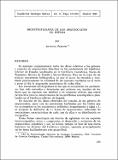Por favor, use este identificador para citar o enlazar a este item:
http://hdl.handle.net/10261/5867COMPARTIR / EXPORTAR:
 SHARE
BASE SHARE
BASE
|
|
| Visualizar otros formatos: MARC | Dublin Core | RDF | ORE | MODS | METS | DIDL | DATACITE | |

| Título: | Bioestratigrafía de los arqueociatos en España |
Autor: | Perejón, Antonio CSIC ORCID | Palabras clave: | Arqueociatos España Cámbrico Inferior Bioestratigrafía |
Fecha de publicación: | 1984 | Editor: | Universidad Complutense de Madrid | Citación: | Cuadernos Geología Ibérica Vol. 9 Págs. 213-265 Madrid 1984 | Resumen: | [ES] Se analizan conjuntamente todos los datos relativos a los géneros
y especies de arqueociatos descritos en los yacimientos del Cámbrico
inferior de España, localizados en la Cordillera Cantábrica, Sierra de
Tamames, Montes de Toledo y Sierra Morena. Pero no se trata de un
trabajo meramente bibliográfico, ya que el autor ha recogido y estudiado
prácticamente la totalidad de las especies reseñadas en el texto
y pone al día la asignación taxonómica de todas ellas.
Las sucesiones estratigráficas en las que se encuentran los yacimientos
han sido revisadas o levantadas por primera vez, muchos de los
datos que se exponen son inéditos y en conjunto ofrecen una nueva
perspectiva para la interpretación de los problemas estratigráficos planteados
en el Cámbrico inferior de España.
En función de los datos obtenidos del estudio de los géneros de
arqueociatos, junto con las precisiones facilitadas por los fósiles que
los acompañan en los yacimientos, trilobites, braquiópodos y algas s. 1.,
se propone la definición de 11 Zonas de Arqueociatos, indicando las
asociaciones características de cada una de ellas y su distribución estratigráfica.
Estas Zonas constituyen un intento de aglutinar en un esquema
bioestratigráfico, único y congruente, el desarrollo y evolución de los
arqueociatos españoles y son, al mismo tiempo, la base de una nueva
hipótesis de división del Cámbrico inferior, apoyada principalmente
en los datos facilitados por este grupo fósil. [EN] We examine in its entirety the data of the archaeocyatha genera and species described in the Lower Cambrian outcrops from Spain, of the Cantabrian Range, Sierra de Tamames, Toledo Mountains and Sierra Morena. Ibis is not a bibliographic paper, since the author has recopilated and studied the whole of the species described in the text and has put their taxonomic assignation up to date, Ihe stratigraphic sequences where the outcrops are found, have been either reviewed or done for the first time. Many of ihe data are unpublished, and as a whole bring a new perspective for the interpretation of the stratigraphic problems in the spanish Lower Cambrian. According to the data fornid of the archaeocyatha genera studied, and with the support of the associated fossils, trilobites, brachiopods and algae s. 1., we propose to determine 11 Archaeocyatha Zones, mdicating íhe characteristie associations of each and their stratigraphic distríbution. These Zones try to unify in a single and congruent biostratigraphic seheme ihe development and evolution of spanish archaeocyatha. They would also be the base for a new hypothesis in dic division of the Lower Cambrian, according mainly to the data of this fossil group. |
URI: | http://hdl.handle.net/10261/5867 | ISSN: | 0378-102X |
| Aparece en las colecciones: | (IGE) Artículos |
Ficheros en este ítem:
| Fichero | Descripción | Tamaño | Formato | |
|---|---|---|---|---|
| JIGE8484110213A.pdf | 2,33 MB | Adobe PDF |  Visualizar/Abrir |
CORE Recommender
Page view(s)
1.264
checked on 23-abr-2024
Download(s)
415
checked on 23-abr-2024
Google ScholarTM
Check
NOTA: Los ítems de Digital.CSIC están protegidos por copyright, con todos los derechos reservados, a menos que se indique lo contrario.
